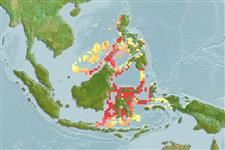>
Coelacanthiformes (Coelacanths) >
Latimeriidae (Gombessa)
Etymology: Latimeria: Taken from Miss Courtenay Latimer worker in the East London Musuem; she contributed to the update of the fish (Coelacanth, Latimeria chalumnae) (Ref. 45335).
Environment: milieu / climate zone / depth range / distribution range
Ecologia
marino demersale; non migratori, usually 150 - ? m (Ref. 33470). Deep-water; 17°C - 20°C (Ref. 33470)
Western Central Pacific: Celebes Sea, north of Sulawesi. Also Ref. 33470.
Size / Peso / Age
Maturity: Lm ? range ? - ? cm
Max length : 140 cm TL maschio/sesso non determinato; (Ref. 33470)
Presumably on rocky slopes in deep water of 150-200 m. Fricke et al. (Ref. 33470) observed two specimens of 120 and 140 cm length in a deep carbonate cave at a depth of 155 m (water temp. 17.8-20.1°C).
Life cycle and mating behavior
Maturità | Riproduzione | Deposizione | Uova | Fecundity | Larve
Pouyaud, L., S. Wirjoatmodjo, I. Rachmatika, A. Tjakrawidjaja, R. Hadiaty and W. Hadie, 1999. Une nouvelle espèce de coelacanthe: preuves génétiques et morphologiques: A new species of coelacanth. Comptes Rendus de l'Académie des Sciences - Series III - Sciences de la Vie 322(4):261-267. (Ref. 30889)
IUCN Red List Status (Ref. 130435)
Threat to humans
Harmless
Human uses
Pesca: di nessun interesse
Informazioni ulteriori
Nomi ComuniSinonimiMetabolismoPredatoriEcotossicologiaRiproduzioneMaturitàDeposizioneSpawning aggregationFecundityUovaEgg development
BibliografiaAcquacolturaProfilo di acquacolturaVarietàGeneticaElectrophoresesEreditarietàMalattieElaborazioneNutrientsMass conversion
CollaboratoriImmaginiStamps, Coins Misc.SuoniCiguateraVelocitàModalità di nuotoArea branchialeOtolithsCervelliVista
Strumenti
Special reports
Download XML
Fonti Internet
Estimates based on models
Preferred temperature (Ref.
123201): 14.9 - 19.4, mean 17.4 °C (based on 5 cells).
Phylogenetic diversity index (Ref.
82804): PD
50 = 1.2539 [Uniqueness, from 0.5 = low to 2.0 = high].
Bayesian length-weight: a=0.01175 (0.00474 - 0.02910), b=3.04 (2.83 - 3.25), in cm total length, based on LWR estimates for this (Sub)family-body shape (Ref.
93245).
Trophic level (Ref.
69278): 4.5 ±0.62 se; based on food items.
Fishing Vulnerability (Ref.
59153): Very high vulnerability (84 of 100).
